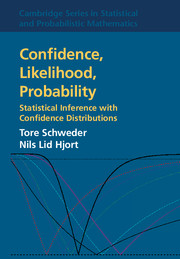Book contents
- Frontmatter
- Dedication
- Contents
- Preface
- 1 Confidence, likelihood, probability: An invitation
- 2 Inference in parametric models
- 3 Confidence distributions
- 4 Further developments for confidence distribution
- 5 Invariance, sufficiency and optimality for confidence distributions
- 6 The fiducial argument
- 7 Improved approximations for confidence distributions
- 8 Exponential families and generalised linear models
- 9 Confidence distributions in higher dimensions
- 10 Likelihoods and confidence likelihoods
- 11 Confidence in non- and semiparametric models
- 12 Predictions and confidence
- 13 Meta-analysis and combination of information
- 14 Applications
- 15 Finale: Summary, and a look into the future
- Overview of examples and data
- Appendix: Large-sample theory with applications
- References
- Name index
- Subject index
2 - Inference in parametric models
Published online by Cambridge University Press: 05 March 2016
- Frontmatter
- Dedication
- Contents
- Preface
- 1 Confidence, likelihood, probability: An invitation
- 2 Inference in parametric models
- 3 Confidence distributions
- 4 Further developments for confidence distribution
- 5 Invariance, sufficiency and optimality for confidence distributions
- 6 The fiducial argument
- 7 Improved approximations for confidence distributions
- 8 Exponential families and generalised linear models
- 9 Confidence distributions in higher dimensions
- 10 Likelihoods and confidence likelihoods
- 11 Confidence in non- and semiparametric models
- 12 Predictions and confidence
- 13 Meta-analysis and combination of information
- 14 Applications
- 15 Finale: Summary, and a look into the future
- Overview of examples and data
- Appendix: Large-sample theory with applications
- References
- Name index
- Subject index
Summary
In this chapter we summarise some of the classical methods and modes of inference in parametric models, with attention given to estimation, confidence intervals and testing. A brief survey of the likelihood-based machinery is included, in particular methods associated with the profile, deviance and root likelihood statistics, and their uses for inference for focus parameters are emphasised. We also discuss various pertinent related issues, such as how the likelihood methods work outside of model conditions, robust alternatives and model selection. This background will serve as part of the platform for our development in later chapters of confidence distributions and their uses. Along with material in the Appendix, this chapter may serve as a mini-course on basic large-sample theory and applications for parametric models.
Introduction
Frequentist statistical inference in parametric models is about reaching relevant statements pertaining to the underlying unknown parameters, based on the observed data. These statements could take the form of a point estimate, perhaps supplemented with standard error (estimate of its standard deviation); a confidence interval or region for one or more functions of the parameters; a test of a hypothesis, often accompanied with a p-value; a comparison between several parameters; construction of a prediction interval for a future data point; and so forth. We argue in the following chapters that the confidence distribution for a focus parameter ought to be added to the statistician's toolbox and report forms.
Though the confidence distribution concepts and methods we develop later on are not limited to, for example, maximum likelihood analyses or indeed to likelihood methods per se, such will always have an important place when analysing parametric models. Sections 2.2–2.4 review classical likelihood methods, including the use of profile likelihood functions, for reaching inference statements for focus parameters.
We note that Bayesian inference adds one more element and aspect to the situation and the list of assumptions, namely so-called prior distributions for the model parameters. This approach is briefly reviewed and discussed in Section 2.5; see also Sections 1.8 and 15.3. In Section 2.6 we also examine how and to what extent parametric models may be seen to work even when the real data-generating mechanism lies outside the reach of the parametric family; essentially we learn that the likelihood methods aim at certain well-defined ‘least false’ parameter values, viewed as those producing the best parametric approximation to the more elusive truth in terms of the Kullback–Leibler distance. Included in that section is also a discussion of certain robust inference strategies.
- Type
- Chapter
- Information
- Confidence, Likelihood, ProbabilityStatistical Inference with Confidence Distributions, pp. 23 - 54Publisher: Cambridge University PressPrint publication year: 2016



